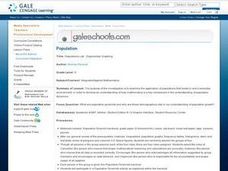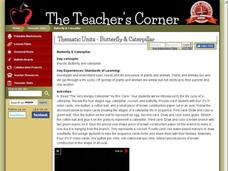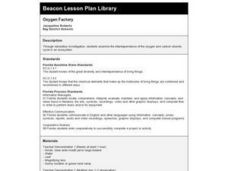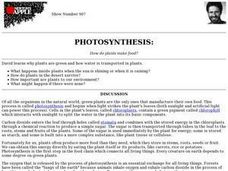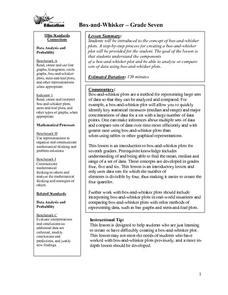Curated OER
"Caterpillars to Butterflies"
Students participate in a variety of activities about how caterpillers become butterflies.
Curated OER
Populations Lab - Exponential Graphing
Ninth graders investigate the application of populations that exists in one's everyday environment, in order to develop an understanding of how mathematics is a key component in the understanding of population dynamics.
Curated OER
Butterfly and Caterpillar
Students listen to the story "The Very Hungry Caterpillar" and create their own "Very Hungry Caterpillar" book to learn the life cycle of a butterfly.
Curated OER
Glucose Factory
Fourth graders determine, through laboratory activity, the presence or absence of glucose in a variety of plant leaves and stems. They work in groups and perform a three part laboratory which shows them how plants convert sunlighht to food.
Curated OER
Oxygen Factory
Fourth graders examine the interdependence of the oxygen and carbon dioxide cycle in an ecosystem through a laboratory investigation. After a lecture/demo, 4th graders complete the lab in groups.
Curated OER
Visual Arts Lesson: St. James on Horseback
Sixth graders research and write on sculpture of St. James and describe his importance to the Spanish soldiers who conquered Mexico; students create their own estofado designs.
Curated OER
The Very Hungry Caterpillar Puppet Book
First graders create their own puppet book to go with "The Very Hungry Caterpillar" book.
Curated OER
Pi Day
Ninth graders explore the concept of pi in preparation for developing a project for pi day. They examine direct variation, the history of pi, circle circumference and arc length, area and sector area and then consider how these concepts...
Curated OER
Photosynthesis: How do plants make food?
Learners study why plants are green and how water is transported in them. They examine how plants respond to different amounts of light.
Curated OER
How Can We Study the Differences in Animal and Plant Cells Using the Compound Microscope?
Students examine their cheek cells with a compound microscope. They identify different parts of the cell. They compare and contrast animal and plant cells with the microscope as well.
Curated OER
Box-and-Whisker
Seventh graders are introduced to the concept of box-and-whisker plots. A step-by-step process for creating a box-and-whisker plot is provided. The goal of the instructional activity is that students study the components of a...
Curated OER
Food Webs
Students recognize interdependence in a food web by using yarn and notecards to create a food web and discussing what would happen if one of the organisms from a certain trophic level is removed.
Curated OER
How One Part Relates To Others
Students observe how objects are put together. In pairs, students identify as many parts of a toy as possible. They explore how the parts fit together and how each part works. Students speculate how the object would be affected if a...
Curated OER
The Grouchy Ladybug By Eric Carle
Second graders complete a unit about ladybugs based on Eric Carle's, The Grouchy Ladybug. They complete comprehension questions, categorization activities, Venn diagrams, and choral readings of Susan M. Paprocki', Little Red Bug. As they...
Curated OER
Very Hungry Caterpillar
Students read "the Very Hungry Caerpiller" by Eric Carle and create their own caterpillers using the same art techniques found in the book in this excellent early elementary lesson. Included with the lesson is a vocabulary list and a...
Curated OER
Cytoplasmic Streaming
Students prepare successful wet mount slide of Elodea. They determine and identify environmental conditions that induce cytoplasmic streaming. They determine the positive aspects of cytoplasmic streaming. They illustrate knowledge and...
Curated OER
Forest Floor Terrarium
Young scholars study the aspects of a forest floor ecosystem, including decomposition, the water cycle, food webs, the needs of living things, and physical vs. chemical change over an extended period. In addition, students conduct...
Curated OER
PLANT IMAGERY
Students study morphological terminology. One student is blind-folded while the other describes a nearby plant. Once the blindfold is removed, the partner tries to find the plant that was described. They share their experience...
Curated OER
Butterflies and Flowers
Students observe and demonstrate the concepts of over, under, and on. Using a cutout of a flower and a butterfly, they identify if the butterfly is over, under, or on the flower. Students complete a worksheet along with the teacher, and...
Curated OER
Observing Specialized Cells
In this plant and animal cell worksheet, students draw five examples of plant or animal cells that are specialized to perform a particular functions. They also complete 6 short answer questions based on their observations.
Curated OER
September Following Directions Activity
In this September worksheet, students follow 10 steps and color in the illustrations according to the directions. Students choose colors based on their opinions about the month of September.
Curated OER
Life Cycle of Trees
For this Life Cycle of Trees worksheet, students read one page about the life cycle of a trees. Students define 12 terms from the reading.
Curated OER
Observing Snail Behavior
In this observing snail behavior activity, students find a few snails, place them in an aquarium, observe for several days, then answer 5 questions about their behavior.
Curated OER
The Rock Cycle
In this rock cycle learning exercise, students will review the characteristics of the three rock types: igneous, sedimentary, and metamorphic rocks. Students will also compare and contrast rocks and minerals. This learning exercise has...
Other popular searches
- Stem and Leaf Plots
- Leaf Structure
- Stem and Leaf
- Leaf Arrangement
- Leaf Classification
- Leaf Diagram Cross Section
- Leaf Identification
- Maple Leaf Flag
- Leaf Collection
- Leaf Turkeys
- Leaf Size
- Stem and Leaf Plots



